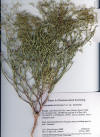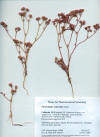
Chorizanthe brevicornu
Newberry Mts., Lake Mead National Rec. Area, NV
Spjut 15282, May 2003
|

Chorizanthe brevicornu
Newberry Mts., Lake Mead National Rec. Area, NV
Spjut 15282, May 2003 |

Chorizanthe staticoides
Transverse Ranges, S of
Palmdale, CA, Spjut 15342,
Jun 2003 |
|
Chung H.S., L.
C. Chang, S. K. Lee, L. A. Shamon, R. B. van Breemen, R. G. Mehta, N. R.
Farnsworth, J. M. Pezzuto and A. D. Kinghorn. 1999. Flavonoid
constituents of Chorizanthe diffusa with potential cancer
chemopreventive activity. J. Agric. Food Chem. 47(1): 36-41. “An
ethyl acetate-soluble extract of Chorizanthe diffusa was found to
exhibit significant antioxidant activity, as judged by scavenging stable
1,1-diphenyl-2-picrylhydrazyl (DPPH) free radicals and inhibition of
12-O-tetradecanoylphorbol 13-acetate (TPA)-induced free radical formation
with cultured HL-60 cells. Bioassay-directed fractionation of this extract
using the DPPH antioxidant assay as a monitor led to the isolation of five
structurally related flavonoids (1-5), including the novel compound
5,8,3',4',5'-pentahydroxy-3, 7-dimethoxyflavone (1). Isolates 1-5
demonstrated varying degrees of antioxidant or antimutagenic activity. Two
of the compounds, 5,7,3', 4'-tetrahydroxy-3-methoxyflavone (2) and
quercetin (4), were subsequently found to inhibit carcinogen-induced
preneoplastic lesions in a mouse mammary organ culture model. Inhibitory
activity of this type is known to correlate with cancer chemopreventive
effects in full-term models of tumorigenesis.”
Lee S. K., Z.
H. Mbwambo, H. Chung, L. Luyengi, E. J. Gamez, R. G. Mehta, A. D. Kinghorn
and J. M. Pezzuto. 1998. Evaluation of the antioxidant potential of
natural products. Comb. Chem. High Throughput Screen 1(1): 35–46. “Since
reactive oxygen radicals play an important role in carcinogenesis and
other human disease states, antioxidants present in consumable fruits,
vegetables, and beverages have received considerable attention as cancer
chemopreventive agents. Thus, in order to identify antioxidants in plant
extracts, test materials were assessed for potential to scavenge stable
1,2-diphenyl-2-picrylhydrazyl (DPPH) free radicals, reduce TPA-induced
free radical formation in cultured HL-60 human leukemia cells, and inhibit
responses observed with a xanthine/xanthine oxidase assay system.
Approximately 700 plant extracts were evaluated, and 28 were found to be
active in the DPPH free radical scavenging assay. Based on secondary
analyses performed to assess inhibition of
7,12-dimethylbenz(a)anthracene-induced preneoplastic lesion formation with
a mouse mammary organ culture model, Chorizanthe diffusa Benth.
(Polygonaceae), Mezoneuron cucullatum Roxb. (Leguminosae),
Cerbera manghas L. (Apocynaceae) and Daphniphyllum calycinum
Benth. (Daphniphyllaceae) were selected and subjected to bioassay-guided
fractionation. 5,7,3',5'-Tetrahydroxy-8,4'-dimethoxyflavonol,
5,8,4'-trihydroxy-7,3'-dimethoxyflavonol,
5,3',4'-trihydroxy-7-methoxyflavonol, and
6,3',4'-trihydroxy-7-methoxyflavonol were identified as active principles
from C. diffusa. Piceatannol, trans-resveratrol, apigenin and
scirpusin A were found as the active principles of M. cucullatum,
olivil, (-)-carinol, and (+)-cycloolivil were active principles from C.
manghas, and 5,6,7,4'-tetrahydroxyflavone 3-O-rutinoside and
kaempferol 3-O-neohesperidoside were active principles from D. calycinum.
Of these substances, the hydroxystilbenes piceatannol and transresveratrol
have thus far been shown to inhibit carcinogen-induced preneoplastic
lesion formation in the mouse mammary gland organ culture model.”
|